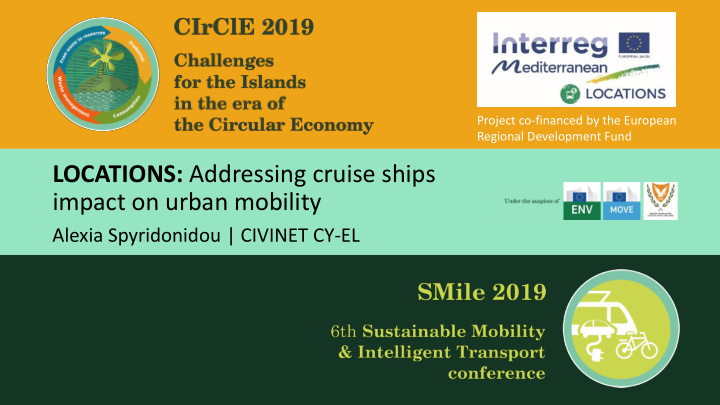



Project co-financed by the European Regional Development Fund LOCATIONS: Addressing cruise ships impact on urban mobility Alexia Spyridonidou | CIVINET CY-EL
Repli licatin ing or organization for LIM IMASSOL
2,7 M BUDGET 1.11.16 START 36 m DURATION
Mission “ Mitigate the impact cruise ships - related traffic has on cities , improving the quality of life of inhabitants and passengers ”
20 ITALY PORTUGAL AREA Science Park (LP) Lisboa e-nova Partners Trieste Port Authority Municipality of Lisbon Municipality of Ravenna 5 SPAIN ALBANIA CIRCE Countries Albanian Institute of Malaga Port Authority Transport 7 Durres Port Authority CROATIA Kvarner REA Port cities Rijeka Port Authority Municipality of Zadar
❑ 1 operational model project ❑ 7 Low Carbon Transport Plans (based on 14 modular main packages ) ❑ 5 further Low Carbon Transport Plans (LCTPs) in outputs LOCATIONS original countries ❑ 6 new technical organizations are trained to replicate the LOCATIONS approach in other MED countries (+6 new LCTPs)
An LCTP Is developed based on a methodology of: 4 steps, 14 measure packages Aims to: • increase cruise cities’ attractiveness and sustainability • improve sustainable mobility of people and goods related to cruise flows • in a long term perspective fosters the use of low carbon transport systems and multi modal connections for cruise related - passengers and freight flows in the frame of wider sustainable traffic and mobility policies (SUMPs)
LCTP work flow
Step 1 – Initial assessment Context analysis Stakeholders identification
Step 2 – Participatory process Getting the e.g. stakeholders consultation on-board meetings Tailored local activities e.g. Reaching out interviews to the cruise passengers
Context analisys, stakeholders ’ involvement & First phase of participatory process DEFINITION OF • Main negative impacts, most urgent issues CURRENT SCENARIO STEP 3 - • Long term problems • Main barriers, opportunities … Draft of the operational VISION AND STRATEGIC OBJECTIVES model Definition of actions and indicators • Main objectives by area of work LOGFRAME MATRIX • Operational goals APPROACH • Activities/ initiatives/ actions …
DEVELOPMENT OF FUTURE SCENARIOS 1- Nothing changes, neither for better nor for worse (Business as usual scenario) STEP 3 - 2- Most positive possibilities foreseen actually occur, surpassing the expected Draft of the outcomes and allowing to incremental adaptations. operational 3- Unexpected events or circumstances, mostly negative for the project, become a significant obstacle and hazard for the fulfillment of foreseen model objectives. 4- Most likely scenario: events occur in the most likely way, progressing to a certain stage (not as good as they could have), but getting low or even stuck in some aspects.
DEVELOPMENT OF FUTURE SCENARIOS STEP 3 - Draft of the operational model DEFINITION OF GENERAL AND SPECIFIC INDICATORS TO MONITOR AND ASSESS PROGRESS LOGFRAME MATRIX APPROACH (Phase 2)
LOGFRAME MATRIX DEVELOPED STEP 3 - Draft of the SECOND PHASE OF THE PARTICIPATORY PROCESS Sharing and discussing objectives operational Gaining support and consensus Fostering empowerment and commitment model LCTP FIRST DRAFT
Step 4 – Monitoring Who What How When
Step 4 – Funding
7 LCTPs finalised & evaluated !
TRANSFERRING & TESTING & REPLICATION ELABORATION 6 new 10 7 LCTPs LCTPs months
5 new countries | 6 new port cities o Cyprus: Limassol o France: Riviera o Greece: Igoumenitsa, Thessaloniki o Malta: Valetta o Slovenia: Koper
CAPACITY BUILDING MANUAL - Step by step guide - References of examples & methodologies - Tools 14 potential measure packages
stay tuned!
Thank nk you u for r your ur atte tentio ntion Alexia Spyridonidou as@civinet.gr (+30)2107710979
Recommend
More recommend